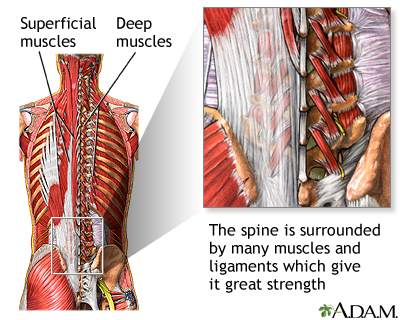
Back pain specialist
Introduction
The purpose of this tool is to help you decide whether or not to see a back pain specialist. When making a decision like this, you must balance:
- The reasons for seeing the specialist
- Whether there are alternatives that may be more appropriate
- Cost
This tool is not a substitute for professional medical care and advice. Ask your regular doctor to help you decide whether it is worth seeing a specialist. There is usually no exact "right" or "wrong" answer.
Your physician may make certain recommendations to you. However, the final decision about whether to see a specialist rests with you.
What does the specialist do?
Back pain is one of the most common complaints that doctors treat. Nearly four out of five people will experience back pain at some time in their life.
The cause of many cases of back pain is often hard to define. (This is called nonspecific back pain.) It may be caused by muscle strain, injury to the back, overuse, muscle disorders, pressure on a nerve root, or poor posture. Pregnant women, smokers, construction workers, and people who perform repetitive lifting all have increased risk of back pain.

A physical examination of the back, abdomen, and the legs or arms may confirm back pain or muscle spasm. A specialist may find weakness or change in sensation during the examination. However, a physical examination alone does not reveal a specific cause (such as a herniated disk).
X-rays of the spine are usually a normal part of seeing a specialist. Further testing may include a CT scan or MRI of the spine. Once the tests are complete, the specialist can recommend treatment.
Key points
Muscle strain is often the cause of back pain. This usually responds to 2 - 5 days of rest and anti-inflammatory pain medications (such as ibuprofen, naproxen, or aspirin), followed by the gradual return to normal activities. You may need prescription medication to reduce muscle spasms.
Primary care doctors often prescribe physical therapy to help treat someone with back pain. Physical therapists can teach patients good posture and correct lifting techniques. Physical therapy can help people learn exercises to improve strength and flexibility in their spine, abdomen, and legs.
You should probably see a back specialist, however, when:
- Severe pain that is very limiting lasts beyond a week.
- You develop weakness or numbness that is not improving.
- You have trouble controlling your bladder or bowels (Call your doctor right away).
- You have back pain that has not improved with treatment, including physical therapy and anti-inflammatory pain medications.
- You have a fever, a history of cancer, or you are also losing weight (Call your doctor right away).
You can see different kinds of specialists for back pain, including:
- A rheumatologist can help, especially if you have arthritis.
- Physical medicine and rehabilitation doctors (also called physiatrists) also treat patients with back pain. They are able to give patients spinal injections to help treat pain.
- You may need to see a spine surgeon if other doctors recommend you need surgery.
How much time this decision tool will take
5 - 10 minutes
What this tool will provide
- A personalized list of factors for you to weigh
- Questions to ask your doctor
- Alternatives to seeing a specialist
- Recommended reading
Reviewed By: Linda J. Vorvick, MD, Medical Director, MEDEX Northwest Division of Physician Assistant Studies, University of Washington, School of Medicine. Also reviewed by David Zieve, MD, MHA, Medical Director, A.D.A.M., Inc.
- Chou R, Qaseem A, et al. Diagnosis and treatment of low back pain: a joint clinical practice guideline from the American College of Physicians and the American Pain Society. Ann Intern Med. 2007;147(7):478-491.
- Hayden JA, van Tulder MW, Malmivaara AV, et al. Meta-analysis: exercise therapy for nonspecific low back pain. Ann Intern Med. 2005;142(9):765-775
- Ratcliffe J, Thomas KJ, MacPherson H, et al. A randomised controlled trial of acupuncture care for persistent low back pain: cost effectiveness analysis. BMJ. 2006;333(7569):626.v



